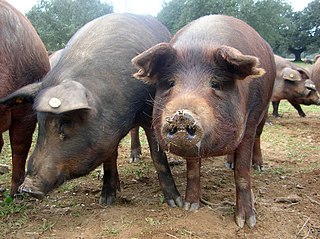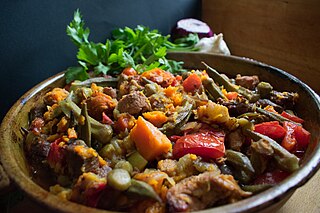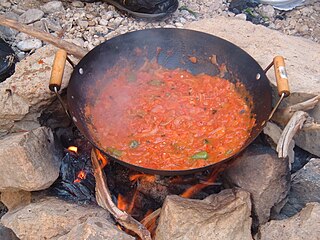
Gazpacho or Gaspacho, also called Andalusian gazpacho, is a cold soup and drink made of raw, blended vegetables. It originated in the southern regions of the Iberian peninsula and spread into other areas. Gazpacho is widely eaten in Spain and Portugal, particularly during hot summers, since it is refreshing and cool.

Spanish cuisine consists of the cooking traditions and practices from Spain. Olive oil is heavily used in Spanish cuisine. It forms the base of many vegetable sauces. Herbs most commonly used include parsley, oregano, rosemary and thyme. The use of garlic has been noted as "common to all Spanish cooking." The most used meats in Spanish cuisine include chicken, pork, lamb and veal. Fish and seafood are also consumed on a regular basis.

Turkish cuisine is the cuisine of Turkey and the Turkish diaspora. It is largely the heritage of Ottoman cuisine, which can be described as a fusion and refinement of Mediterranean, Balkan, Middle Eastern, Central Asian and Eastern European cuisines. Turkish cuisine has in turn influenced those and other neighbouring cuisines, including those of Southeast Europe (Balkans), Central Europe, and Western Europe. The Ottomans fused various culinary traditions of their realm taking influences from and influencing Mesopotamian cuisine, Greek cuisine, Levantine cuisine, Egyptian cuisine, Balkan cuisine, along with traditional Turkic elements from Central Asia, creating a vast array of specialities. Turkish cuisine also includes dishes invented in the Ottoman palace kitchen.

The zucchini, courgette or baby marrow is a summer squash, a vining herbaceous plant whose fruit are harvested when their immature seeds and epicarp (rind) are still soft and edible. It is closely related, but not identical, to the marrow; its fruit may be called marrow when mature.

Scrambled eggs is a dish made from eggs stirred, whipped or beaten together while being gently heated, typically with salt, butter, oil and sometimes other ingredients.

Moussaka is an eggplant- or potato-based dish, often including ground meat, which is common in the Balkans and the Middle East, with many local and regional variations.

A schnitzel is a thin slice of meat. The meat is usually thinned by pounding with a meat tenderizer. Most commonly, the meat is breaded before frying. Breaded schnitzel is popular in many countries and is made using veal, pork, chicken, mutton, beef, or turkey. Schnitzel is very similar to the dish escalope in France and Spain, tonkatsu in Japan, cotoletta in Italy, kotlet schabowy in Poland, milanesa in Argentina, chuleta valluna in Colombia, and chicken-fried steak and pork tenderloin of the United States.

Migas is a dish traditionally made from stale bread and other ingredients in Spanish and Portuguese cuisines. Originally introduced by shepherds, migas are very popular across the Iberian Peninsula, and are the typical breakfast of hunters at monterías in southern Spain.

Levantine cuisine is the traditional cuisine of the Levant.

Valencian cuisine is a Mediterranean cuisine as cooked in the Valencian Community, Spain. Its basic ingredients are vegetables, seafood and meat. It is famous worldwide for its rices, such as paella, and its citrus fruits. The cuisine of neighbouring regions have given and received important contributions from Valencian gastronomy, amongst them Balearic cuisine, Catalan cuisine, Aragonese cuisine, Manchego cuisine and Murcian cuisine.

Manchego cuisine refers to the typical dishes and ingredients in the cuisine of the Castilla–La Mancha region of Spain. These include pisto, gazpacho manchego, Manchego, the white wine of La Mancha, and the red wine from Valdepeñas (DO).

Picadillo is a traditional dish in many Latin American countries and the Philippines. It is made with ground meat, tomatoes, and also raisins, olives, and other ingredients that vary by region. It is often served with rice or used as a filling in dishes such as tacos, savory pastries or croquettes. The name comes from the Spanish word picar, meaning "to mince".

Stuffed peppers is a dish common in many cuisines. It consists of hollowed or halved peppers filled with any of a variety of fillings, often including meat, vegetables, cheese, rice, or sauce. The dish is usually assembled by filling the cavities of the peppers and then cooking.

Ratatouille, Occitan: ratatolha[ʀataˈtuʎɔ](listen), is a French Provençal dish of stewed vegetables which originated in Nice, and is sometimes referred to as ratatouille niçoise. Recipes and cooking times differ widely, but common ingredients include tomato, garlic, onion, courgette (zucchini), aubergine, capsicum, and some combination of leafy green herbs common to the region.

Gachas is an ancestral basic dish from central and southern Spain. Its main ingredients are flour, water, olive oil, garlic, paprika and salt.

Extremadura, Spain is known for its different ways of preparing the Iberian pork and mutton. The main characteristics of the traditional Extremaduran cuisine were its simplicity, its lack of clutter and its low cost. It is also a cuisine reflecting a generous spirit, for many of its preparations used to be cooked in large pots to share with visitors, friends, and neighbors. The resulting dishes are eaten with local bread.

The bocadillo or bocata, in Spain, is a sandwich made with Spanish bread, usually a baguette or similar type of bread, cut lengthwise. Traditionally seen as a humble food, its low cost has allowed it to evolve over time into an iconic piece of cuisine. In Spain, they are often eaten in cafes and tapas bars.

Torta de gazpacho is a type of torta, or flat bread, used to prepare a dish called gazpacho or gazpacho manchego in La Mancha and Southeast Spain, including Murcia and parts of the autonomous community of Valencia.

Türlü is a casserole of Turkish cuisine. It is made of stewed vegetables and may also include stewed meat. Varieties of this dish are also found in Balkan cuisines. In particular, it is known as turli perimesh in Albania, tourlou or tourlou tourlou in Greece, and as turli tava in North Macedonia.

Qalayet bandora is a simple Jordanian and Palestinian dish of tomatoes, onions, hot peppers, olive oil, and salt. It is popular across the Levant, but especially in Jordan on account of its easy preparation and healthy ingredients. To make the dish, the olive oil is heated in a large frying pan. The onions and peppers are diced and the tomatoes are cubed and optionally peeled. The onions are then added and cooked until translucent, at which point the rest of the ingredients are added and the mixture is sautéed until it is thick but not dry. Qalayet bandora is usually eaten with warm pita bread, which is used to scoop it up, though Qalayet bandora can also be served over rice and eaten with utensils. When served in a restaurant or at a formal event, it is often garnished with toasted pine nuts.






















